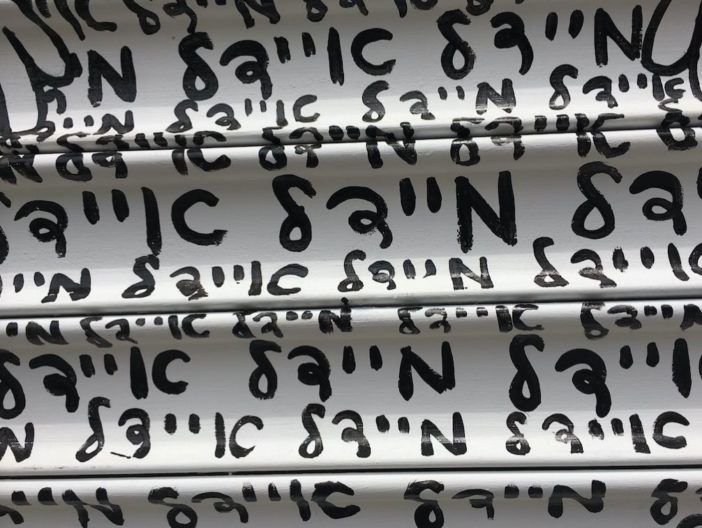From Ultra-Orthodox Jewish Sect To Street Artist: Sara Erenthal Shows Her ‘Three Selves’


If you’ve passed by Sir D’s Lounge on Union Street over the last months, you’ve likely noticed a stylized mural of three women painted on a rolled gate next to the cafe’s entrance.
At quick glance, the women appear stylistically similar — all with red lips, geometric, a variety of clothing and hair style. Stop for a moment, and you may notice them staring across the street at the Food Coop or Dixon’s Bike Shop.
Or perhaps the figures are asking you to look at them.
Move closer to the mural, and you’ll see three very different individuals. However, artist Sara Erenthal has painted the same person — who has lived multiple lives. Titled SarasThreeSelves, the work is autobiographical and layered with a stunning and tremendous life transition.

The first self on the left is “Eidel meidel” — which is written out in Yiddish on her dress. The term translates to “good submissive modest Jewish girl.”
This youngest self grew up in a family which belonged to Neturei Karta, a sect of Charedi, or Ultra-Orthodox Judaism. The Neturei Karta are opposed to Zionism, holding the firm belief that the state of Israel should not exist before the arrival of the Messiah.
In her upbringing, Erenthal was required to wear her hair in braids, and could not wear short sleeves or pants. She was not allowed to ride a bike. The “first self” did not go to art galleries or museums.
“I did take one silly art class. We drew a bowl of fruit,” recalls Erenthal. “But the teachers actually supported me. They saw something in me.”
The artist describes the middle figure as her awkward self. “This is the girl who leaves her family,” she explains. She fled from an arranged marriage at age 17 and joined the Israeli Defense Forces. Her journey took her to a left-wing kibbutz and later to backpacking in India, where she says that she began to draw.
“People pick up hobbies when they travel in India,” Erenthal explains. “And I began to draw. I never decided I was going to be an artist — something happened on its own.”

The third self is Erenthal today — the visual and performance artist. She has not been trained as such. “It’s the struggles you go through that inspire you,” she says. “I now accept what I went through. That’s my voice.”
Trained or not, the artist’s aesthetic is striking and instantly recognizable. And while she does show her work in galleries and exhibitions, she is committed to creating art on found objects.
Erenthal has lived in the Park Slope neighborhood for about eight months, and she has already made her craft part of the streets — literally.

“When I walk around the neighborhood and someone throws out a mattress, I paint the mattress,” she explains.
For Erenthal, creating public art is a priority. “I love the idea of not everything going through the institutional art world,” she says.
Erenthal points out that she often creates this way out of necessity.
“I use what I have,” she says. “I don’t always have money for canvasses and paint. Sometimes I draw with coffee because that is what I have.”
In addition to disposed objects becoming her palette, Erenthal also likes to use words in her work. “There’s something about writing on walls that’s very freeing,” she says.

Observers of her work will notice what looks to be the word “ART” drawn on each of her pieces. “Actually, those are my initials in Sanskrit,” explains Erenthal. “But I like that it looks like the word ‘art’.”
Displacement, survival, and liberation make up the core of the work Erenthal creates. “Maybe I can help people who have similar situations in restrictive backgrounds do what they want,” she says.
And those who connect to her work are not limited to ex-Ultra-Orthodox Jews. “There are many restrictive backgrounds — and I hope my work can speak to others.”
Erenthal recalls one of the more powerful responses to her craft. “One woman came up to me and told me how much pain she saw in my work. She told me she had been gang-raped and she could relate to it.”
“If I’ve affected one person, I am doing a good job.”
Upcoming Exhibitions for Sara Erenthal:
Some/Body, a group exhibition
When: Through Sunday, August 14
Where: 212 Arts, 240 East 4th Street, Manhattan
Hours and Information: View their website here.
Brooklyn: Juxtaposition
When: Through Sunday, August 14
Where: Repair The World, 808 Nostrand Avenue, Brooklyn
Hours and Information: View their website here.



